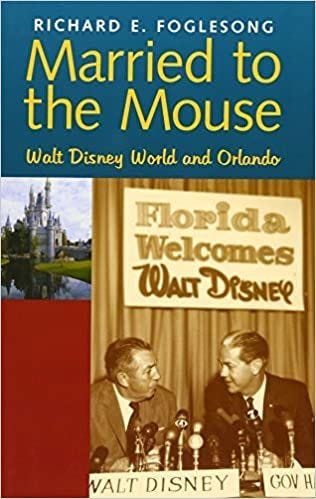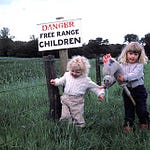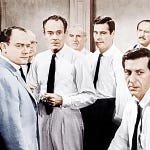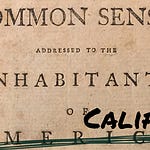
Condensed Transcript
[Richard’s comments in italics]
When Walt Disney set out to build Disney World, he envisioned a political subdivision over which the Disney Corporation would have almost exclusive control over the functions of municipal government — from the fire department to the building codes.
He succeeded, and although the Reedy Creek Special Improvement District would not be codified until shortly after his death, Disney’s dream of a “magical autonomous kingdom” lives on in the center of the Sunshine State.
Today, we debate whether this experiment represents the wave of the future of free cities, or merely the power of large corporations to push local government around. Florida Governor Ron DeSantis says it’s time to revoke Disney’s special status and force them to play by the same rules as every other developer in the state.
Historian and political scientist Professor Richard Foglesong joined me to discuss whether we should aspire to let independent corporations run all American cities.
We begin with Walt’s vision — not his creative, artistic vision or innovations in animation, but with the story of how a bunch of orange groves in a comfortable part of the country came to be the mega-city and theme park it is today. Foglesong reports:
Walt Disney wanted a place to take his grandchildren where there wouldn’t be any “carny” type workers. He built Disneyland in 1955, but they had a problem in dealing with the city of Anaheim in California. They didn’t like depending on the municipality to provide public services, which they wanted tailored to their exact needs.
In particular, Richard mentions the problem of having city regulators inspecting so-called black box buildings, containing potentially dangerous rides. Disney thought itself better equipped to regulate the safety of its attractions. The company did not want to be free of regulation in order to be reckless or save money by cutting corners. Instead, it supported the goals of internal regulation, which often exceeded municipal standards.
A 178-foot-tall castle was not the sort of thing that government could easily regulate. [Disney] wanted to be in charge of designing buildings to be safe, and the same with providing public services: water, police, fire, sewer, and infrastructure generally.
When they set out to build “Disneyland East,” they considered which jurisdictions would give them the most autonomy to develop their vision.
The sparsely populated region surrounding Orlando, Florida had a lot going for it: warm weather, two major expressways, and a large swath of underutilized, fertile land. The day that Disney decided to build Disney World in Orlando was the same day that President Kennedy was assassinated: “A fateful day for the nation in a bad way,” Richard notes, “But also a fateful day for the state of Florida, because that’s when the theme park in Orlando began. Ever since then, Orlando has been the #1 tourist attraction in the United States.”
Richard says it’s unclear whether Disney wanted to actually build a city or just a theme park. He found evidence that they wanted something like a city, but most importantly, they wanted self-control and a way to “escape from democracy” — to design and build Disney World without the government interfering.
I found documents where a company attorney was explaining to Walt Disney that they couldn’t exactly escape democracy. He asked his aids whether he could build an experimental monarchy, and it was kind of laughed off. But a man named Paul Helliwel — an attorney for the company — explained to Walt that, on the one hand, they had to comply with democracy, but that on the other, they could maybe escape from it.
How did the corporation keep the Reedy Creek Improvement District — a land area the size of Manhattan — under private control? They set up a two-tiered government. One tier comprised two “phony cities”: Bay Lake and Lake Buena Vista. These two cities had a combined population of 52 people — all loyal Disney executives and long-term employees — who elected a government with all of the typical powers granted to a municipal. The Reedy Creek Improvement District, however, elected its government on the basis of “one acre one vote.” This second tier thus functioned as something like an absolute monarchy, and the municipal powers given to the first tier were also effectively transferred to Reedy Creek. It’s been called the “The Vatican with Mouse Ears,” since it is basically an independent state within the borders of Florida.
Before we start complaining about Disney’s aversion to democracy, it’s important to recall that our Founders were extremely suspicious of too much democracy. Furthermore, the concept of independent special districts is not that unusual — we have 10s of thousands of them across the country. Disney just used the concept to its particular advantage.
What can we learn from Disney World as a model of private enterprise?
Richard asks a related question about why most American cities are relatively ugly compared with European cities and speculates that it may be due to the fact that American cities are “the first cities in world history, built under the conditions of capitalism and democracy … [whereas] European cities like Paris, for example, were built under authoritarian rule.”
Here, we might pause to consider the paradox of Disney’s vision of a model free-enterprise city controlled by an “experimental monarchy.” With centralized power comes creative control and the ability to plan. It’s not unlike gated communities that tell you what color to paint your house, how to plant your garden, etc. Homeowners in these communities surrender their freedom for the benefit of a uniform aesthetic. So, how livable is Disney World under its benevolent dictatorship?
Disney is a very livable place. It has about 350,000 people sleeping there, on any given day, they’re just not real residents. They’re not citizens of the property, they don’t get to vote.
Richard distinguishes between democracy as a political system and as a governing mechanism for building things efficiently and artistically.
Everything is coordinated — the colors, the greenery, the shape of the buildings, etc., and people like being there. Even when it rains people are still smiling.
The smiles also appear on the faces of the “public servants,” i.e., Disney employees, whose mission it is to keep customers happy. While this may be pleasant to be around, Richard points out the possible downside to always being happy.
There are some social psychologists who find it repressive that a company should want to control your emotions — that they should require you to smile, and grade you on whether you smile and how effectively you smile. Don’t get me wrong. I like the Disney employees. I like being in a Disney park. But I wouldn’t want to personally be graded on how well I smile.
I’m reminded of a time when I traveled from New York to a lawyer’s convention at Disney World. By the morning of the third day, I found myself wishing there was an 800 number I could call to just talk sarcastically to somebody and have them be sarcastic back. I would have paid for sarcasm by the word.
Yet Disney’s emphasis on the customer experience speaks to the relationship we have to service providers as opposed to with the government. If a service provider doesn’t make you better off, you stop patronizing them. City governments perform much better when they face competition too. People are frequently voting with their feet (including from New York to Florida), which leads New York to reform its policies.
What stopped Disney from moving forward with the original vision of an actual village – Epcot – was the fact that they were afraid of democracy.
The Disney vision of an experimental free enterprise municipality depended on the customers of the resort being temporary residents rather than full-time citizens, with voting privileges. Walt Disney worried that the voting residents would mess things up, or complain at City Council about the way things were done.
Disney’s Pre-Nup
In exchange for the autonomy it received from the city of Orlando and the state of Florida, Disney World provided tourism dollars. These powers were institutionalized in the form of the Reedy Creek Improvement District charter and financial structure, which was written in a way that made them hard to revoke. Today, Ron DeSantis wants to take away these powers – not because he is bothered by Disney’s autonomy, Richard says, but because the company disagreed with him about LGBTQ rights. Both sides have benefitted tremendously from the deal. Disney has by far the largest tax bill in Orange County, but they also enjoy certain exemptions from fees other developers have to pay. From a practical standpoint, Richard suspects that DeSantis might not be able to move forward with his plan to strip Disney of its powers:
I think that in the end, Disney will still have its power… because someone has to retire those bonds that Disney is able to sell. If Reedy Creek goes away, it would no longer have the ability to tax itself to retire the bonds. Someone else therefore would have to compensate bondholders. I don’t think either Orange County or Osseola County homeowners will want to pay an extra couple thousand dollars for municipal bonding just to satisfy Governor DeSantis. Someone else is going to have to foot that bill.
The Big Takeaways from the Marriage of Disney World and Orlando, Florida?
Richard believes that Disney World teaches us that companies can be an efficient way to build a city. Democracy is still important to guarantee civil rights and other freedoms, but most municipal functions can be handled privately.
DeSantis shouldn’t break up the successful relationship, but instead, seek to resolve his differences with Disney through some other means. Does anyone know a good couples therapy for a corporation and municipal government?














Disney World's Model for Cities of the Future